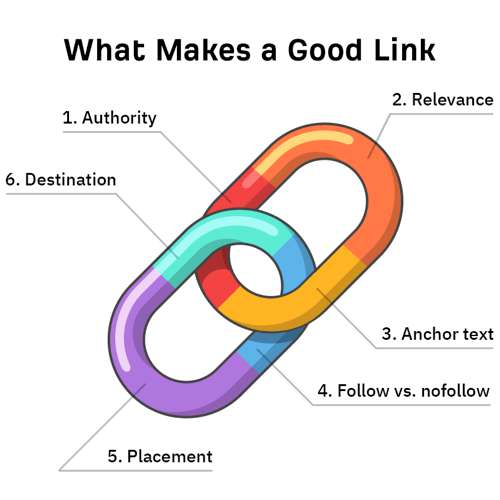A Little Trip Down Memory Lane
Back in the day (we’re talking late 90s, early 2000s), link building was the Wild West of SEO.
I remember when I first started in this field, people were doing all sorts of crazy stuff to get links.
Spamming comments, buying links by the thousands – you name it, someone tried it.
But then, in 2017, Google decided enough was enough.
They released an update, dubbed “Penguin,” and it absolutely rocked the boat!
All of a sudden, all those spammy tactics stopped working. Sites that were riding high on fake links came tumbling down faster than a house of cards in a hurricane.
The Golden Rule: Quality Over Quantity
Now here’s the thing: links still matter. A lot. But it’s not just a numbers game; it’s about quality as well.
It’s like your friend group, basically.
Would you rather have a tonne of acquaintances who barely know you, or a smaller circle of close friends who’ve got your back?
Google’s looking for those close friend links—the ones that come from reputable sites in your industry.
As Neil Patel, a well-known digital marketing expert, puts it, “Getting a link from a high-quality, relevant website is like getting a recommendation from a trusted friend”.
Building Links: It’s Not Rocket Science, But It’s Close
Alright, so we know we need good links. But how do we get them? Well, buckle up, because we’re about to go on a little adventure through the land of link building.
Step 1: Know Your Keywords
Before you set foot out there trying to get links anywhere, you had better know what you want.
It’s like taking a road trip. You can’t drive aimlessly for long without knowing where you’re headed.
Once there was a client of mine who specialised in handcrafted fine leather bags.
Which keywords were they going for? Luxury handbags, naturally. That should have them ranking in no time!
But when we took a spin around the block, we discovered something interesting—their genuine niche was “handmade leather goods.”
After that, their rankings just went up!
Step 2: Create Content That’s Worth Linking To
This is a hard fact: nobody wants to hook up with boring, run-of-the-mill content.
What you have to do is create stuff that grabs people’s attention.
Consider what type of content you enjoy sharing. Probably stuff that’s:
- Super helpful
- Really interesting
- Makes you laugh
- Teaches you something new
And that’s the content you have to create.
And I promise you, it’s not always easy. I once dedicated three weeks to researching and writing a guide to sustainable leather practices.
It was a passion project, but you know what?
That guide got picked up and linked to by multiple big fashion blogs and even an environmental non-profit.
Step 3: Spread the Word
All right, now, you have your killer content. Now what? Now it’s time to share it with the world!
This is where many, many people get hung up.
They produce amazing content and then simply… wait. However, there is a caveat — the online realm is a cacophonous one.
If you want to be heard, well, you’ve got to make some noise yourself.
Here are some ways to get your content out there:
1. Reach out to industry influencers
Find the big names in your field and let them know about your content.
But don’t just spam them! Build a relationship first. Comment on their blogs, share their stuff on social media. Then, when you reach out, they’ll be more likely to listen.
2. Guest posting
It is still one of the best ways to get links. Search for blogs in your industry that accept guest posts, then pitch them your ideas.
Most importantly, make quality posts for your feed!
3. Be active on social media
Share your content, engage with others, and be a part of the conversation in your industry.
4. Participate in online communities
Go where your audience hangs out – Forums, Reddit, Quora.
When I first started doing this, I was so scared of talking to people.
What if they ignored me?
What if they said no? But you know what? The truth is that most people are nice.
I once emailed a name-brand fashion blogger, knowing she’d probably ignore me.
They not only responded, but they included my client’s bags in a roundup post!
Step 4: Mix It Up
Here’s something a lot of people get wrong—they focus all their energy on getting links from the biggest, most authoritative sites.
And sure, those links are great.
But Google likes to see a mix of links from all kinds of sources.
Think about it like this: if you only had friends who were CEOs and celebrities, wouldn’t that look a bit… suspicious? Google feels the same way about links.
So don’t ignore those smaller blogs or niche forums. A diverse link profile looks more natural to Google, and that’s exactly what we want.
Step 5: Keep It Natural
Speaking of natural, let’s talk about anchor text. That’s the clickable text in a hyperlink, for those who might not know.
Back in the day, people used to use the exact same anchor text for every link, thinking it would help them rank for that term.
Big mistake! Google’s too smart for that now.
Instead, mix up your anchor text. Use variations of your keywords, use your brand name, use generic terms like “click here” or “read more.”
Heck, sometimes just use the URL itself as the anchor text.
I once worked with a site that had over-optimised their anchor text.
Every single link pointing to their homepage used the exact same keyword phrase.
We spent months cleaning that up, reaching out to site owners and asking them to change the anchor text.
It was a pain, but it worked—their rankings recovered, and they learned a valuable lesson about natural link building.
The Long Game: Patience Pays Off
Here’s the thing about link building – it’s not a sprint, it’s a marathon. You’re not going to see results overnight.
But if you stick with it, consistently creating great content and building relationships in your industry, you’ll start to see those links (and those rankings) grow.
I’ve seen it happen time and time again.
One client I worked with spent six months consistently creating and promoting great content.
For a while, nothing seemed to happen.
But then, around the seven-month mark, things started to take off.
Their rankings improved, their traffic increased, and suddenly, people were reaching out to them for links and collaborations.
Link building isn’t easy. It takes time, effort, and a whole lot of patience.
But it’s still one of the most effective ways to improve your search engine rankings and drive more traffic to your site.
Remember:
- Create content worth linking to
- Build relationships in your industry
- Promote your content (don’t be shy!)
- Keep your link profile diverse and natural
- Be patient and persistent
And most importantly, always focus on providing value.
Whether you’re creating content, reaching out to other site owners, or participating in online communities, ask yourself: “Am I adding value here?”
If the answer is yes, you’re on the right track.
So, what are you waiting for?
Get out there and start building some links!
And hey, if you’ve got any cool link building stories or tips of your own, drop them in the comments. I’d love to hear them!





